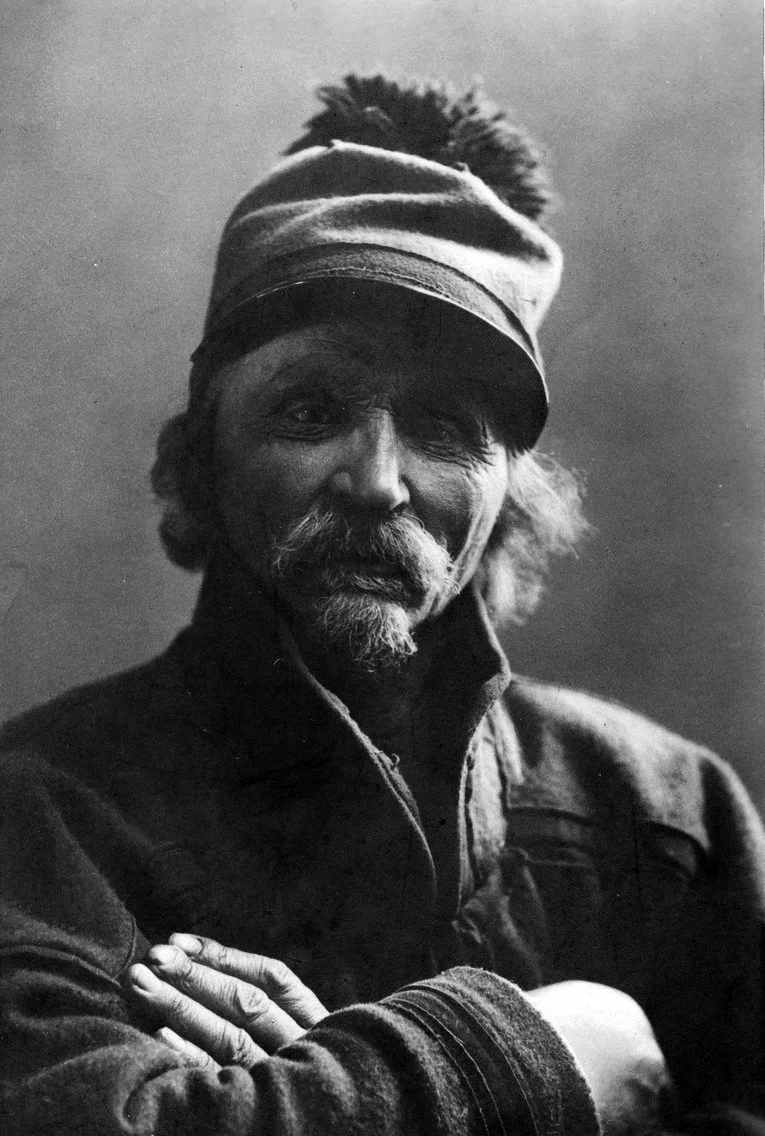Johan Turi. Self-portrait. Date unknown. Mixed technique on thick paper (pastel, gouache and ink, or similar). 32.2 x 25.2 cm (irregular). The Johan Turi Archives. Nordiska Museet, Stockholm. LA 659, No. 11, Box J1:1. Photo: Nordiska Museet.
Photographer unknown (Borg Mesch?). Portrait of the Sámi author and artist Johan Turi (1854-1936). c. 1910–1916. Photograph. Nordiska Museet. NMA.0056710.
Who was Johan Turi?
A North Sámi artist, writer, hunter, and occasional tourist guide, Johan Turi (1854–1936) was born in Guovdageaidnu/Kautokeino, Norway, but emigrated early in life with his reindeer herding family to the area of Čohkkiras/Jukkasjärvi, Sweden. He is the author of the first book in which the Sámi intentionally spoke back to their colonizers, the state administrations of Sweden and Norway. Titled Muitalus sámiid birra in the North Sámi language and published in Copenhagen in 1910, it included an atlas with fourteen line-drawings by the author. The Danish ethnographer and artist Emilie Demant Hatt assisted Turi in writing the book. Financial support by Hjalmar Lundbohm, mining executive in Giron/Kiruna, made the publication possible.
Turi aimed at protecting Sápmi, “the general concrete and abstract concept referring to [the] … people, land and spirit” of the Sámi (Keskitalo 1994, 7), from the effects of colonization by settlers, mining companies, forestry, tourism, and so on. In Muitalus sámiid birra Turi focused specifically on the seasonally travelling reindeer herders in the historical region of Torne lappmark (a Swedish geographical term meaning “Sámi land”), spanning six Sámi siidas, among them Talma to which the Turi-family belonged. A siida is the traditional social, economic, and geographical organization unit of a Sámi community. A premise on which Turi’s work rests is that the Sámi is an Indigenous people: “One never hears about the Sámi’s arrival, as if they had come from somewhere else. The Sámi have always lived in these parts, here in the Sámi homeland” (Turi 2012, 11).
His drawing is probably a self-portrait. Turi has signed it with an extra “h” to his name, perhaps as embellishment. The given price, 10 Swedish crowns, is quite typical for him, but very modest indeed compared to what professional artists achieved at the time for their landscape drawings and paintings of northern Sweden.
A prominent detail is the hat with its large red tassel, the wide collar and shoulder band of red, yellow, and blue, and the black belt at the waist with a knife in a bowed sheath. He is wearing a gákti reminiscent of those used in the regions of Čohkkiras/Jukkasjärvi or Giron/Kiruna and its details fit with what Turi might have worn, though his preserved, tasselled hat also has a front brim (Nordiska Museet).
But where is he standing? The surroundings consist of visible brushstrokes of green and yellow against a beige ground. The vibrant colours indicate a summerly, fertile flora. In addition, patches of white with hints of blue have been added to the immediate left and right of the face and neck, as if to highlight his head.
The meaning of such a figurative self-portrait is to invigorate the personal, physical features of a living and acting human being. Compared to known portraits of Johan Turi, we do find corresponding facial features, in addition to his clothes and knife. Why, then, we may ask, do bodily proportions appear distorted, namely the large head and the minute arms and hands? On the one hand, we see similar traits in other portraits by Turi, such as his drawing of the Swedish King Gustav VI Adolf (Nordiska Museet). On the other hand, there is also a possible compositional reason for this personal and idiosyncratic use of proportions. The formal modifications strengthen the figure's main, upright shape. The great head contributes to an impression of an overall, formal unity within which details such as his beard, hair, ear, lips, eye, eyebrow, and wrinkles, are held together. The colours of the face and head are closely related to the ground of the image, the light beige of the paper itself. The darker beige of his skin counterweighs the neighbouring areas of blues, yellows, reds, and greens. As a result, the shape of the head and face, the tiny arms and the general colour scheme make his body stand out from its coloured surrounding areas.
The gesturing right arm of the portrayed, his parted lips, and his calm gaze might hint at him being engaged in a dialogue with someone outside the image to the left. Created shortly after a journey to Copenhagen in 1911 and a year following the publication of his book Muitalus sámiid birra, Turi's self-confidence was at a peak. This seems reflected in the picture. Taken as a self-portrait, it imbues Johan Turi with self-assurance and monumentality.
Essay by Svein Aamold
References
Keskitalo, Alf Isak. 1994. Research as an Inter-Ethnic Relation. Paper originally presented at the 7th Meeting of Nordic Ethnographers, Tromsø, Norway, 1974. Republished, Arktisen keskuksen tiedotteita, no. 11, Dieđut, no. 7. Rovaniemi: Arctic Centre, University of Lapland; Guovdageaidnu: Sámi Instituhtta.
Turi, Johan. 2012. An Account of the Sámi. Edited and translated by Thomas A. Dubois. Kárášjohka: ČálliidLágádus.
Further reading
Svein Aamold. 2017. ‘Representing the Hidden and Perceptible: Johan Turi’s Images of Sápmi’, in Sámi Art and Aesthetics, edited by Svein Aamold et.al. Aarhus University Press. 69-98.

